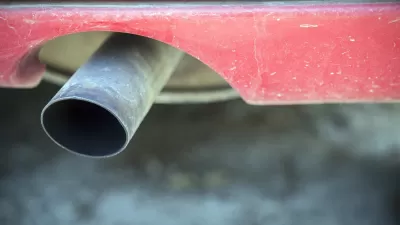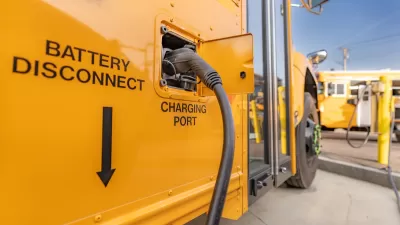U.S. PIRG wants states to use funding from multi-billion dollar Volkswagen settlements to convert the nation's school bus fleet, 95% of which is diesel-powered, to zero-emission buses to reduce children's exposure to toxic air pollution.

The campaign, launched May 3 by the United States Public Interest Research Group (U.S. PIRG), touts the public health and environmental benefits of converting the nation's 480,000 school vehicles to zero-emission buses. It coincides with the release of a new report, “Electric Buses: Clean Transportation for Healthier Neighborhoods and Cleaner Air" [pdf], by the U.S. PIRG Education Fund, Environment America Research & Policy Center, and the Frontier Group.
Approximately 95 percent of U.S. school buses run on diesel, even though numerous studies have shown that inhaling diesel exhaust can cause respiratory diseases and worsen existing conditions such as asthma. The negative effects are especially pronounced in children.
The good news is that all-electric buses are available and ready to roll, and they’re cleaner, healthier and often cheaper for school districts and bus contractors to run in the long-term. And with zero tailpipe emissions, electric school buses can significantly reduce our kids’ exposure to toxic fumes.
Figure ES-1. Estimated Annual Operating Costs of Transit Buses, by Fuel Type

Courtesy of U.S. PIRG
Currently there are pilot programs run by California (Los Angeles County and Gilroy), Massachusetts and Minnesota to test zero-emission school buses. They may involve the conversion of diesel buses as well as purchasing new ones.
One source of funding stems from the $14.7 billion settlement, as well as subsequent settlements in the Volkswagen diesel emissions scandal, first exposed in September 2015 by West Virginia University researchers.
"The VW Environmental Mitigation Trust [stemming from the Volkswagen Clean Air Act Civil Settlement] will provide states with a total of $2.9 billion for projects to cut nitrogen oxide from large vehicles, including school buses," reports Thomas McMahon for the School Bus Fleet blog on April 25. However, school districts will have lots of competition for these funds from transit buses, trucks and other commercial applications ranging from forklifts to port cargo handling equipment.
The report also looked at the environmental benefits of converting the nation's 70,000 transit buses to battery-electric. More than 60 percent run on diesel, 18 percent on natural gas, while just 0.2 percent of buses are all-electric.
Hat tip to AASHTO Journal.
FULL STORY: Electric Buses: Clean Transportation for Healthier Neighborhoods and Cleaner Air

Alabama: Trump Terminates Settlements for Black Communities Harmed By Raw Sewage
Trump deemed the landmark civil rights agreement “illegal DEI and environmental justice policy.”

Planetizen Federal Action Tracker
A weekly monitor of how Trump’s orders and actions are impacting planners and planning in America.

Why Should We Subsidize Public Transportation?
Many public transit agencies face financial stress due to rising costs, declining fare revenue, and declining subsidies. Transit advocates must provide a strong business case for increasing public transit funding.

Understanding Road Diets
An explainer from Momentum highlights the advantages of reducing vehicle lanes in favor of more bike, transit, and pedestrian infrastructure.

New California Law Regulates Warehouse Pollution
A new law tightens building and emissions regulations for large distribution warehouses to mitigate air pollution and traffic in surrounding communities.

Phoenix Announces Opening Date for Light Rail Extension
The South Central extension will connect South Phoenix to downtown and other major hubs starting on June 7.
Urban Design for Planners 1: Software Tools
This six-course series explores essential urban design concepts using open source software and equips planners with the tools they need to participate fully in the urban design process.
Planning for Universal Design
Learn the tools for implementing Universal Design in planning regulations.
Caltrans
Smith Gee Studio
Institute for Housing and Urban Development Studies (IHS)
City of Grandview
Harvard GSD Executive Education
Toledo-Lucas County Plan Commissions
Salt Lake City
NYU Wagner Graduate School of Public Service





























